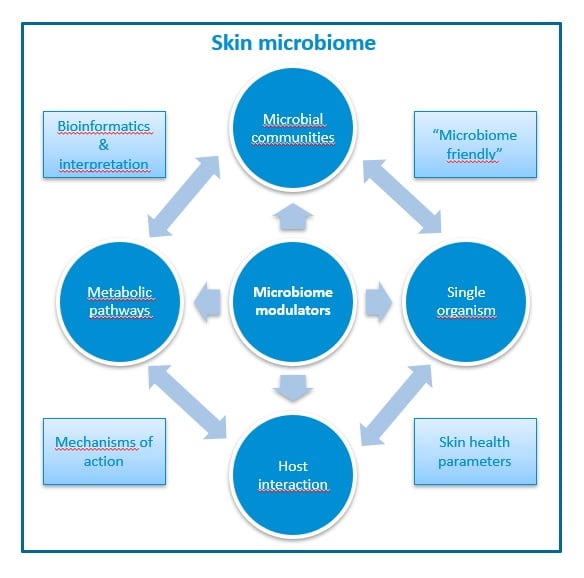Skin health is big business: in 2021, the global market for skin care products was estimated at more than €130 billion. As consumers seek more ‘natural’ products to improve skin health, there is increased attention on the role of the skin microbiome.
Guus Kortman, Scientist and Senior Project Manager Microbiomics, and Janneke Ouwerkerk, Department Head Microbiology, at NIZO, explain how ingredients that modulate the skin microbiome may offer promising new opportunities for manufacturers – but it’s not an easy fix.
What is the skin microbiome, and what is its role in skin health?
Guus Kortman: The human skin is naturally home to a diverse microbiome of bacteria, fungi, viruses and other microorganisms. Some of these help protect the skin, for example by producing short chain fatty acids (SCFA) that can lower skin pH, or skin nutrients and lipids that impact skin condition. Microorganisms can also train and support the skin immune system, and fend off pathogenic threats.
However, certain skin conditions can be linked to overgrowth of bacteria or fungi. Eczema, for example, is often associated with Staphylococcus aureus, acne can be associated with particular phylotypes of Cutibacterium acnes, and dandruff may be associated with Malassezia spp. Overgrowth has been linked to genetic predisposition, stress, the skin’s pH level, diet and many other factors.
The microorganisms interact with the skin’s layers, with each other, and with environmental factors: everything from sunlight to pollution to skin creams, etc. ‘Good bacteria’ can kill off ‘bad bacteria’, and vice versa. Even the face masks worn during the Covid pandemic have had an impact. It’s an incredibly complex, diverse ecosystem, and not as much is known about it as, say, the gut microbiome.
Can skin health be impacted by modulating this skin microbiome?
Janneke Ouwerkerk: Manufacturers of cosmetics, foods, etc. can add components and ingredients to their products that promote the growth of beneficial bacteria, or inhibit the growth of others. Probiotics, prebiotics, postbiotics (also known as ‘ferments’), plant extracts and more can be used in topical products to help maintain the microbiome’s balance and thereby promote skin health, while meeting consumer demand for more ‘natural’, ‘green label’ ingredients. Skin health can also be promoted by oral products with similar ingredients that aim to promote ‘beauty from within’ via the gut-skin axis.
A manufacturer may want to modulate the microbiome for a general ‘skin health’ benefit. For example, a bacterium that produces skin-beneficial SCFAs or moisturizing factors might be added to a topical cream. Certain lactobacilli strains in particular have been shown to reduce skin inflammation and improve barrier function.
There is also the potential for a more targeted approach, to resolve specific skin disorders. For example, if research shows that non-acned skin tends to have more of a certain bacterium than acned skin, a manufacturer may want to add an ingredient that encourages the growth of that bacteria, to see if it helps reduce acne. However, the microbiome organisms don’t always act the way we expect them to. Therefore, this is much more complicated than simply identifying a microbiome modulator, and adding it to a product.
How can you test the effect of an ingredient on the microbiome?

GK: Through a combination of in vitro research and clinical trials that target the human skin microbiome. There are a number of different in vitro models that can be used. NIZO’s Microskin model, for example, mimics the nutritional conditions on the skin that microbes have to cope with. Using a culture medium with callus (dead skin cells) from donors, the impact of microbiome modulators on the growth and metabolism of common skin bacterial strains can be measured in a biologically relevant matrix.
3D models, on the other hand, use cultured skin cells from a donor (healthy or with a skin condition). They have multiple, differentiated layers on which microorganisms or microbiota can be applied, to study host-microbe interactions. They thus enable more in-depth testing, including pH, hydration, skin layer integrity, etc.
Clinical tests can then be used to determine if the ingredient has an impact on the skin in humans. For general skin condition, you might look at, for example, skin elasticity or transepidermal water loss, which correlates with barrier function. For an ‘anti-aging’ product, parameters could include the appearance of wrinkles, fine lines and pore size. More targeted results might be a reduction in acne or dandruff.
What role do data analysis and interpretation play?
GK: With the complexity of the skin, the microbiome and even the components, a general analysis of the data from screenings and testing will provide only limited information. It’s important to look not just at composition, but also at function. Microbiome profiling can be used to identify the microbial communities. 16S sequencing is useful here, but techniques such as shotgun metagenomics, computational system biology and classical microbiology can be used to assess the functional aspects of the community and help discover mechanisms of action.
Interpretation, backed by solid microbiology, then provides greater insight. For example, if the clinical trial shows that the ingredient improves a skin parameter, such as acne, you can correlate that to the growth (or reduction) and function of specific bacterial strains.
JO: Furthermore, just as products can influence the skin microbiome in a positive way, there is a risk that they can have a harmful effect. The same types of tests and analyses can be run on products to make sure they are ‘microbiome-friendly’. This provides a greater understanding of the impact of the product on the skin microbiome than a simpler ‘yes/no’ screening that only evaluates whether the product disturbs the balance of microbiome, but not how or why.
What overall advice would you give to a manufacturer that wants to add a microbiome modulator to a product?
JO: When a manufacturer adds a microbiome modulator to a product, it isn’t only a marketing decision. They should make sure it really works, that the active ingredient functions throughout the product’s shelf life, that the formulation (such as cream versus serum) is optimised to deliver the benefit, etc. But this requires an understanding of how the component functions, the mechanisms of action, what exactly is happening to the microorganisms of the microbiome when the ingredient is added. Building that understanding requires a solid scientific approach and biologically relevant expert knowledge that most manufacturers don’t have in-house. So, it is important to choose a research and development partner with the needed expertise.

